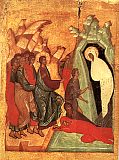

| Previous day | Next day |
| Old Style
April 7
|
Saturday |
New Style
April 20
|
|
Sixth Week of Great Lent (Palm Week). Lazarus Saturday.
Tone 5.
Great Lent. Caviar, wine and oil allowed. |
Caviar, wine and oil allowed.
|
![]() Lazarus Saturday
Lazarus Saturday ![]() St. George the Confessor, bishop of Mytilene (820).
St. George the Confessor, bishop of Mytilene (820).
Martyr Calliopus, at Pompeiopolis in Cilicia (304). Hieromartyr Rufinus, deacon, and Martyrs Aquilina and 200 soldiers, at Sinope (ca. 310). St. Daniel of Pereyaslavl, founder of St. Daniel Monastery (1540). St. Serapion the Sindonite, monk, of Egypt (V). St. Nilus, founder of Sora Skete (Belozersk) (1508). Uncovering of the relics of St. Serapion, archbishop of Novgorod (1517). St. Gabriel, archbishop of Ryazan and Zaraisk (1862).
New Hieromartyr Arcadius Dobronravov, archpriest, of Tsivilsk (Chuvashia) (1933).
St. Hegesippus the Chronicler, of Palestine (ca. 180). Venerable Brynach of Wales (6th c.). St. George, patriarch of Jerusalem (807). St. Gerasimus, hieromonk, of Patmos (1739).
Repose of Schemamonk Theodore of Svir (1822) and Schemamonk Agapitus the Blind, of Valaam (1905).
Thoughts for Each Day of the Year
According to the Daily Church Readings from the Word of God
By St. Theophan the Recluse

Saturday. [Heb. 12:28–13:8; John 11:1–45]
To whomever has work-loving Martha, who symbolizes comprehensive good works, and who has Mary sitting at Jesus’ feet, symbolizing an attentive and warm appeal to the Lord with all the heart, the Lord Himself will come and will resurrect Lazarus, who symbolizes his spirit, and will release him from all his emotional and fleshly bonds. Then a truly new life will begin in him, bodiless in the body and unearthly on the earth. It will be a true resurrection in the spirit before the future resurrection, which will be together with the body!
Articles
 St. George the Confessor the Bishop of MytileneSaint George, Metropolitan of Mytilene, from his youth he led a monastic life, and was especially accomplished in the virtue of humility. |
 Venerable Daniel the Abbot of Pereslavl-ZalesskySaint Daniel of Pereslavl (in the world Demetrius) was born around 1460 in the city of Pereslavl-Zalessky. |
 Venerable Serapion of EgyptSaint Serapion lived during the fifth century in Egypt. He was called the linen cloth-wearer (Sindonite) since he wore only a coarse linen garb called a “sindon.” |




